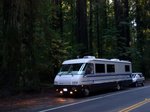Motorhome vehicles have two battery sources….. the engine batteries (with a diesel, two 12v batteries hooked up in parallel) which start and sustain the needs of the engine, and house batteries (in our case four 6v batteries – with two each batteries cabled in series to form a 12v battery and then cabled in parrallel to make up two 12v batteries) used to supply power to the ‘house’.
The lighting fixtures are 12v and use the battery power directly. The TV’s, microwave, satellite, DirecTV receivers and other 110v equipment is supplied (while not hooked to a 110v power line) by an inverter the changes the 12v power to 110v power. Heavy power users, like the roof air conditioners and the washer & dryer, require the RV to be hooked to a 110 shore power line or running the on-board Onan generator.
The Bus was built in November, 2007, so the existing house batteries were approaching 5 1/2 years old. This is “old” for house batteries because it represents a lot of discharges and recharges! I considered sealed batteries so that I would not have to maintain water levels in the batteries and keep the corrosion under control. In the end, decided that I would make another ‘battery cycle’ with the wet cell batteries. The deciding factor was $109 each vs $435 each……….. and needing four batteries!
That’s the background for non-RV’ing readers, and what follows is a description of what I did, including some pictures.
To begin with, I turned the house breaker off on the shore power to disconnect the 110v supply to the inverter battery charger. I then cut of the main house battery disconnect switch, and a 12v disconnect switch inside the Bus at the entry door. I left the inverter on because without shore power, the inverter battery charger should not be trying to charge the batteries. In the end, it did not matter, because without a 12v supply, the inverter tripped off!!
Here is what the battery compartment looked like when I began……
The small grey box located on the end of the third battery from the left is a ‘temperature’ monitor to regulate the charge cycle. I posted some questions about the battery change-out, on the Tiffin RV Network (TRVN), and got a recommendation to relocate this monitor to a negative battery post…….. which I did after the change-out.
Here is a picture of the compartment after most of the cables were removed. Note in the subsequent pictures that I lined up the new batteries next to the BUS, and as I took each cable off, I put it where it would go on the new bank of batteries. NOTE: I did not put nuts on the posts!!!!!!!!!!! Then, when I had removed the old batteries, I then place the cables on them before setting the new batteries in place.
Before setting the new batteries in place, I thoroughly cleaned up the compartment. At the front edge of the compartment floor, there were three screws that had deteriorated from rust and battery corrosion. I removed them and replaced them with new stainless steel screws that I coated with Anti-Corrosion spray--- see the paper plate in the picture above.
Here is a poor picture of one of the corroded screws, but you will get the idea. I included pictures of the empty compartment (before and after cleaning………
The second picture shows a close-up of the dirt that was in the compartment…. mostly road grime that probably came in through the unused round hole shown in the last two pictures. I found a piece of plastic (cut from the bottom of a paint roller pan), and covered the hole. You can also see the thick electrical tape that I put on the “+” main cable to prevent any ‘accidents’. The cover is shown here………
With the compartment cleaned and ready, I set the four new batteries in place…………
I then took each cable one at a time from the ‘old battery setup’ on the driveway, cleaned the cable and lugs with lighter fluid, and installed it where it went. The lighter fluid did a good job of cleaning both the cable and the old corrosion inhibitor from the lug. Note: The nuts that came with the new batteries did not have the ‘lock washers’ attached like the old ones, and since the nuts were like new, I reused them.
After installing all of the cables, I connected the batteries to the BUS system and waited for the sparks…….. but there were none!!
I checked the tightness of each nut, installed the grey box on a negative battery post, and tidied up the wiring from it. The only thing left to do was to apply corrosion inhibitor on the battery connections, and re-install the hold-down bracket
I cleaned up the hold-down bracket and primed it and then painted it with a spray can of ‘truck bed paint’ from Lowe’s.
I am planning to reference this post on the TRVN forum. If anybody reads it, you need to pay close attention to clearance to get the cell caps off to add water. A point of concern is in the lower left hand corner above with the ground cable connection.






















2 comments:
Richard,
Nice write-up on changing out batteries. Fortunately, I don't need to do that yet, but will refer back to your blog when I do.
See you in a few weeks.
Great post. The Battle Born 100Ah deep cycle battery gives you the advantages of lithium-ion for a great price and is the best RV house battery. Get more information visit:http://www.powergenixsystems.com/best-rv-battery-under-review/
Post a Comment